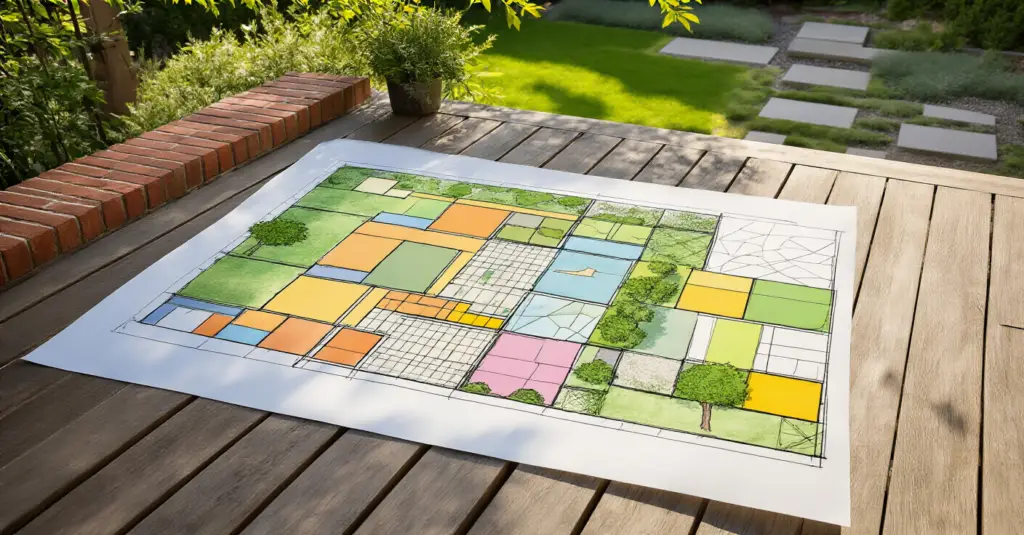You know what people always ask me? They have this beautiful vision for their backyard, this little slice of heaven they see on Pinterest, but they have no idea how to make it feel right. They’ll show me pictures of stunning patios and perfect gardens, but then they’ll say, “It just feels like a yard, Willow. Not a sanctuary.” And I get it. It’s the missing piece in almost all design talk.
We get so caught up in how a space looks that we forget how it speaks to our other senses. The secret isn’t just about what you see; it’s about what you hear, what you smell, what you feel on your skin. That’s the real story of creating a space that doesn’t just look good but genuinely nurtures your well-being. So let’s talk about how to weave that sensory magic into your backyard, turning it into the retreat you can feel in your bones.
Foundation & Smart Planning
Can we talk about how everyone gets this part wrong? They jump straight to buying furniture or plants. But that’s like trying to bake a cake without preheating the oven. Planning isn’t the boring part; it’s the most mindful part. It’s where you tune in. You listen to the land, you listen to your own needs, and you create an energetic blueprint. This is where you decide how you want to feel before you decide what you want to buy. Without this, you’re just decorating. With it, you’re creating a sanctuary.
1. Sketch Your Dream Layout to Visualize Zones
People see sketching as just drawing boxes for a grill and a table. But I want you to think of it as emotional cartography. Instead of “patio,” maybe you map out a “zone of connection.” Instead of “garden,” you create a “space for quiet contemplation.” Take a piece of paper and map the energy you crave. Where does the morning sun hit, begging for a spot to sip your coffee and energize for the day? Where does that corner feel protected and quiet, perfect for a reading nook to decompress?
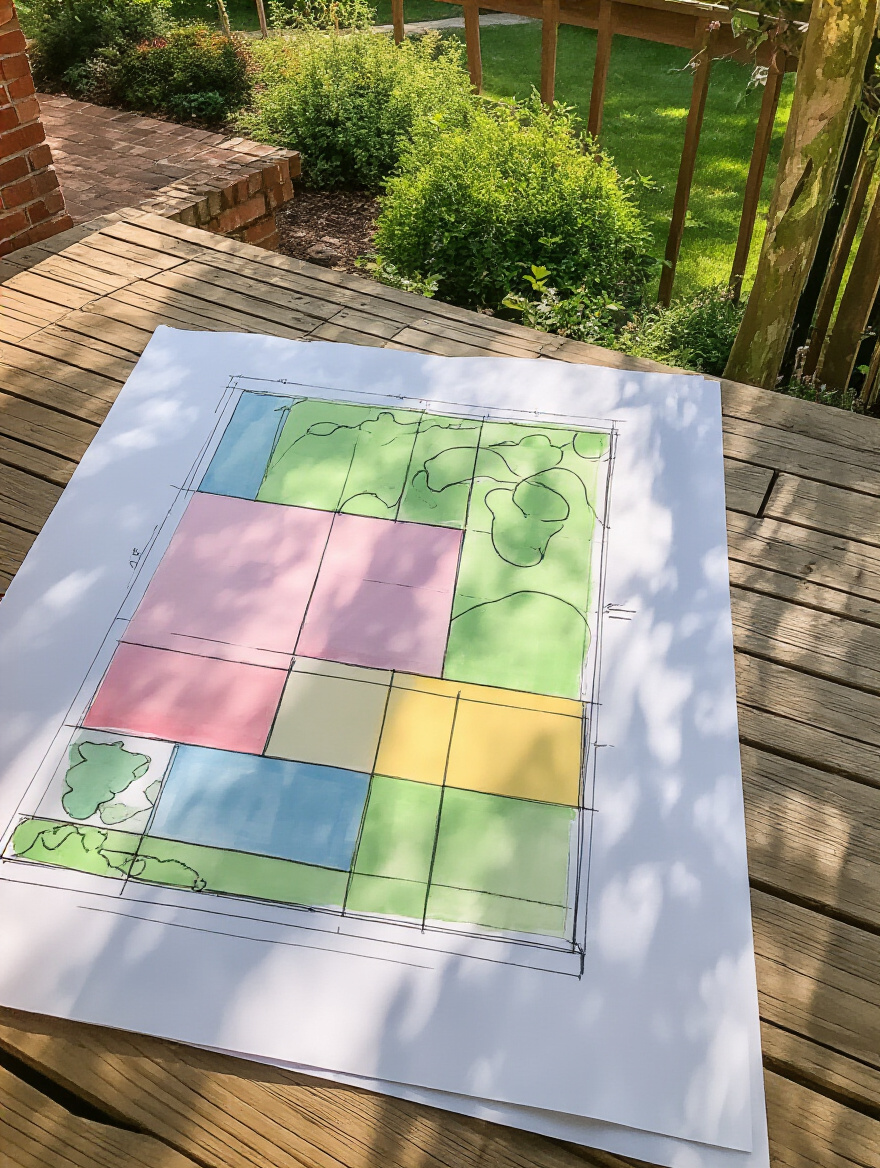
I once had a client who was ready to build a massive, central patio because that’s what he thought he “should” do. I had him sit in his yard for a full weekend and just notice. He realized he craved a small, secluded spot in the back corner to watch the birds. We reoriented the entire plan around that small moment of peace. Ditching the “shoulds” and tuning into your own emotional needs is the only shortcut that works. It ensures the space serves you, not just impresses guests.
From this energetic map, you begin to layer in the most powerful force in any garden: the sun itself.
2. Assess Sun & Shade Patterns for Optimal Placement
This is about so much more than preventing sunburn on your plants. The sun dictates the entire sensory rhythm of your day. Honoring its path is like choreographing a dance between you and your environment. Where does the cool, gentle morning light fall? That’s where you place a yoga mat or a bench for quiet intention. Where is the shade deep and inviting in the heat of the afternoon? That’s your haven for a nap in a hammock, a space to retreat and cool down.
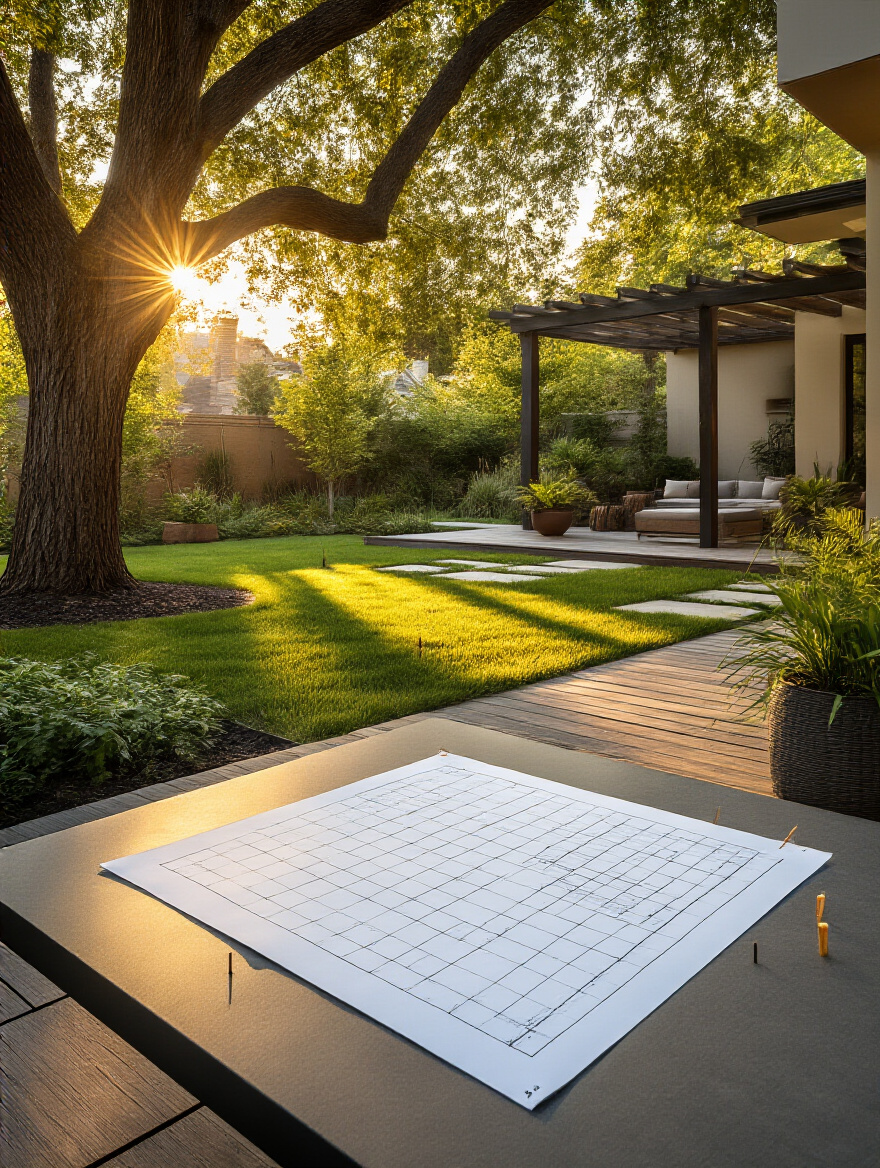
So many people fight their yard’s natural state, and it’s a losing battle. They put a sun-drenched dining area on the west side and wonder why no one wants to eat dinner there until 9 p.m. Observe for a few days. Notice how the light changes, how it feels on your skin at different hours. I use an app called Sun Seeker to show clients exactly where shadows will fall, but honestly, a lawn chair and a notebook work just as well. When you align your activities with the sun’s natural energy, your backyard starts to feel like it’s effortlessly working with you.
Now that you understand the flow of light, you can give each of these spaces a true purpose.
3. Define Backyard Zones for Focused Functionality
Once you know the energy and light of your space, you can create your outdoor “rooms.” And this isn’t about building walls. It’s about creating sensory cues. A zone for dining might be defined by the sound of crunching pea gravel underfoot, while a relaxation zone might be on a soft outdoor rug that signals your brain it’s time to take your shoes off and unwind. This isn’t just about organizing space; it’s about giving your mind and body permission to shift states.
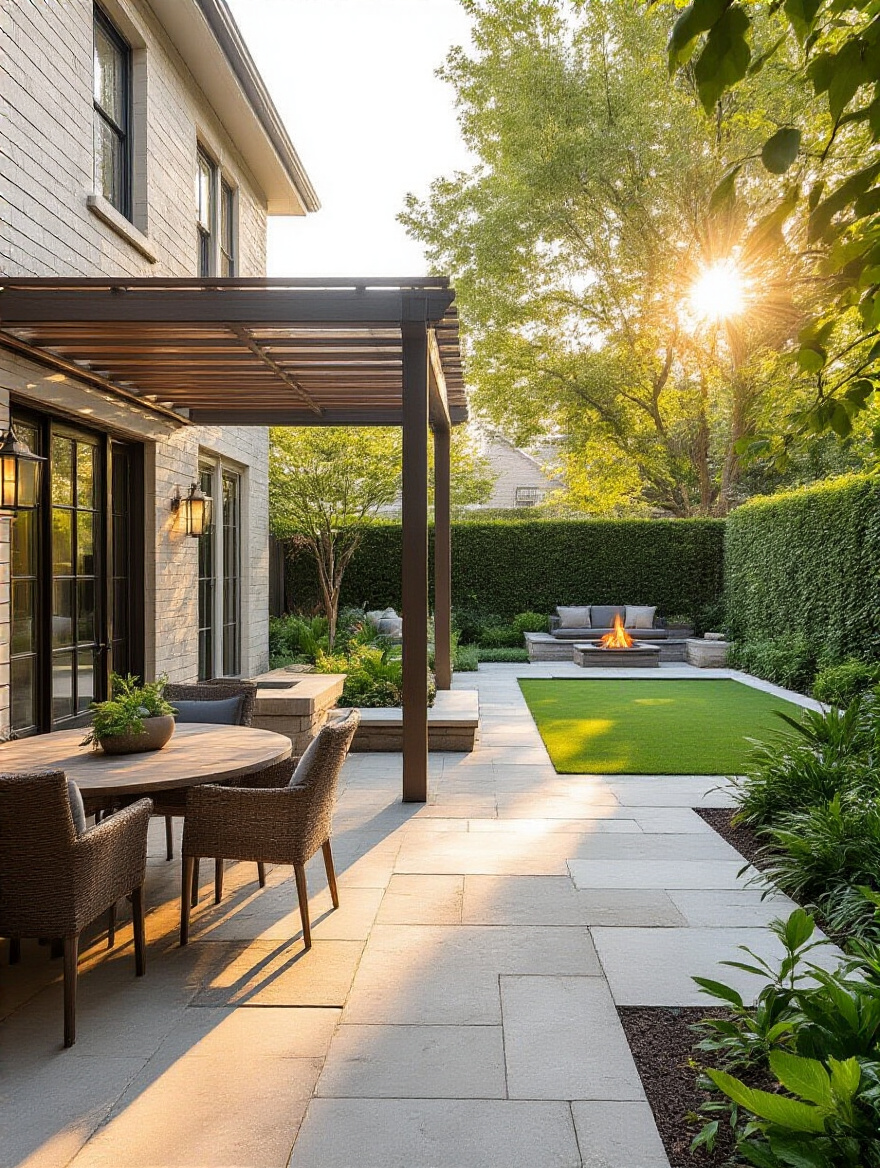
You can delineate these zones with a shift in materials, a low-slung hedge of fragrant lavender, or a curtain of rustling bamboo. It creates intimacy. I once worked with a family whose large, open lawn felt overwhelming and unused. We simply laid an outdoor rug, arranged a few chairs, and hung some string lights. Suddenly, this vague space became “the lounge,” and they started spending every evening out there. You’re not just breaking up a yard; you’re crafting distinct experiences that invite you to live more fully in each one.
Defining these beautiful experiences is the fun part, but grounding them in reality is what brings true peace of mind.
4. Create a Realistic Budget for Project Success
Let’s be honest: nothing kills a sanctuary vibe faster than financial stress. A budget isn’t a restriction; it’s a permission slip to relax. It’s the ultimate act of self-care for a project like this. It takes the anxiety out of the equation so you can actually enjoy the process. The biggest mistake people make is only budgeting for the big-ticket items—the patio, the pergola—and forgetting everything else. The soil, the delivery fees, the extra bag of mulch, the one pot you just had to have.
This is my advice: research your “must-have” costs, then add a 15-20% buffer. Always. That isn’t for mistakes; it’s for reality. An unforeseen drainage issue, a price hike on cedar, or the brilliant idea you have halfway through. That buffer is what allows the project to breathe. Tracking it all on a simple spreadsheet means you’re in control. You can make conscious choices, deciding to splurge on the incredibly comfortable chairs because you saved on the DIY fire pit. It’s how you honor both your dream and your financial well-being.
Once your finances are in order, there’s one last checkpoint to ensure that calm lasts.
5. Research Local Building Codes Before Starting
This is the least glamorous part, I know. But it is the bedrock of your peace of mind. Truly. There is nothing more soul-crushing than pouring your heart, energy, and money into a beautiful new deck, only to be told by a city inspector that it has to be torn down. I’ve seen it happen, and it’s heartbreaking. These rules aren’t there to annoy you; they’re there to ensure your beautiful sanctuary is safe and sound for years to come.
Before you dig a single hole, visit your city or county’s website. Look up the rules for decks, fences, sheds, and electrical work. Pay attention to “setbacks,” which is how far a structure needs to be from your property line. It seems tedious, but this 30 minutes of research can save you thousands of dollars and immeasurable stress. Think of it as creating a solid, unshakable foundation—not just for your deck, but for the sense of security you’ll feel every time you step outside.
Crafting Core Structures & Hardscapes
Now we get to build the bones of your sanctuary. These are the elements that give the space shape, texture, and flow. Think of hardscapes as the strong, steady rhythm, and the plants we add later as the melody. These structures aren’t just functional; they are deeply sensory. They define how you move, where you gather, and what you feel underfoot. This is where your vision starts to become a physical reality you can touch and experience.
6. Install a Permeable Paver Patio for Durable Enjoyment
A patio is often the heart of a backyard, but let’s think beyond a sterile slab of concrete. A permeable paver patio is a choice that honors the earth. Instead of creating runoff, it allows rainwater to gently seep back into the ground, just as it would in a forest. There’s a beautiful sensory story here. Imagine the sound of a summer rain shower not splashing and pooling, but being quietly absorbed by the ground beneath you.
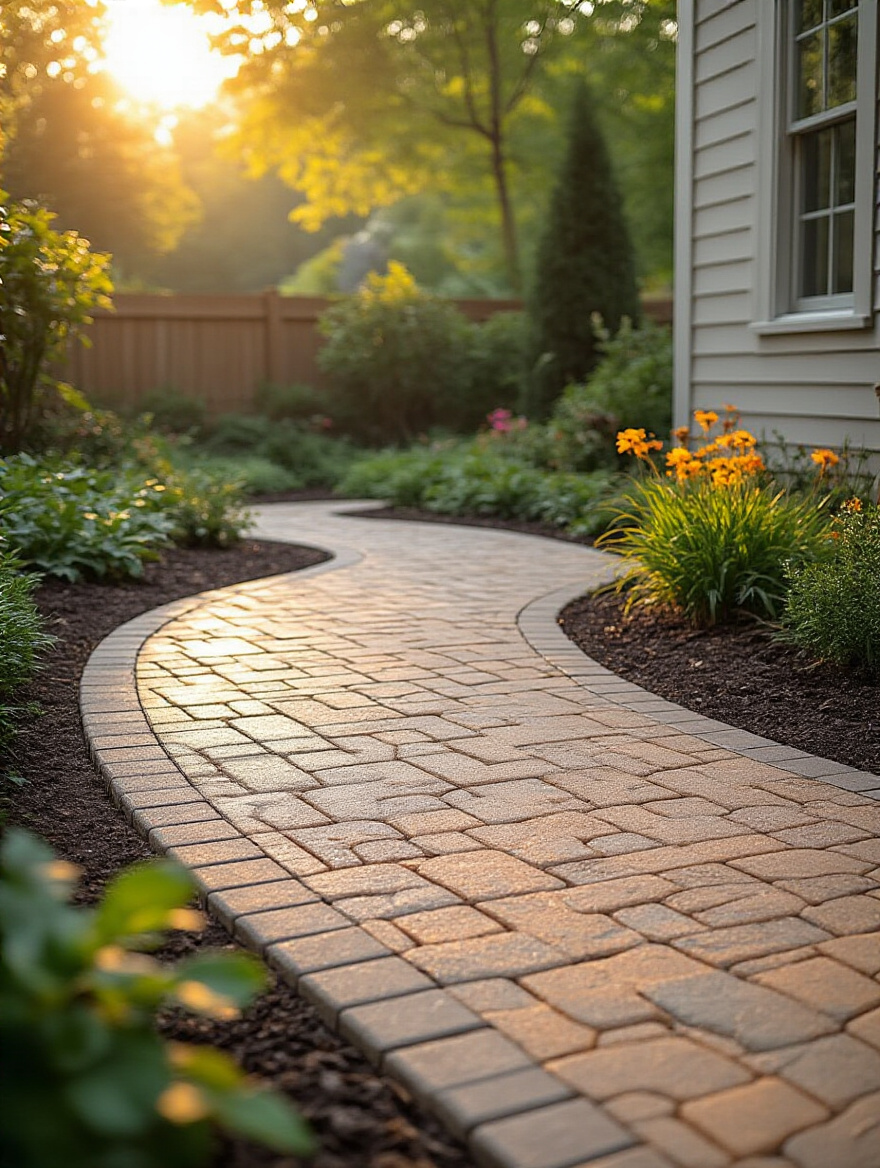
The feeling underfoot is solid yet alive. It’s a sustainable choice that also prevents puddles and icy patches, making the space safer and more usable. A client in a very rainy part of the Pacific Northwest chose this for their main seating area, and they were amazed at how it completely solved their soggy yard problem. They said it made their whole garden feel healthier and more balanced. It’s a foundational choice that says, “This home is in partnership with nature.”
With the heart of your gathering space in place, we can begin to define its edges with natural beauty.
7. Define Garden Edges with Natural Stone Borders
Can we just talk about the simple, profound beauty of a stone border? It’s one of my favorite ways to add a sense of grounding and permanence to a landscape. This isn’t just a physical barrier to keep mulch in place; it’s a visual cue that calms the mind. Our brains love clean lines and gentle order amid the beautiful chaos of a garden. A stone edge provides that sense of soothing definition.
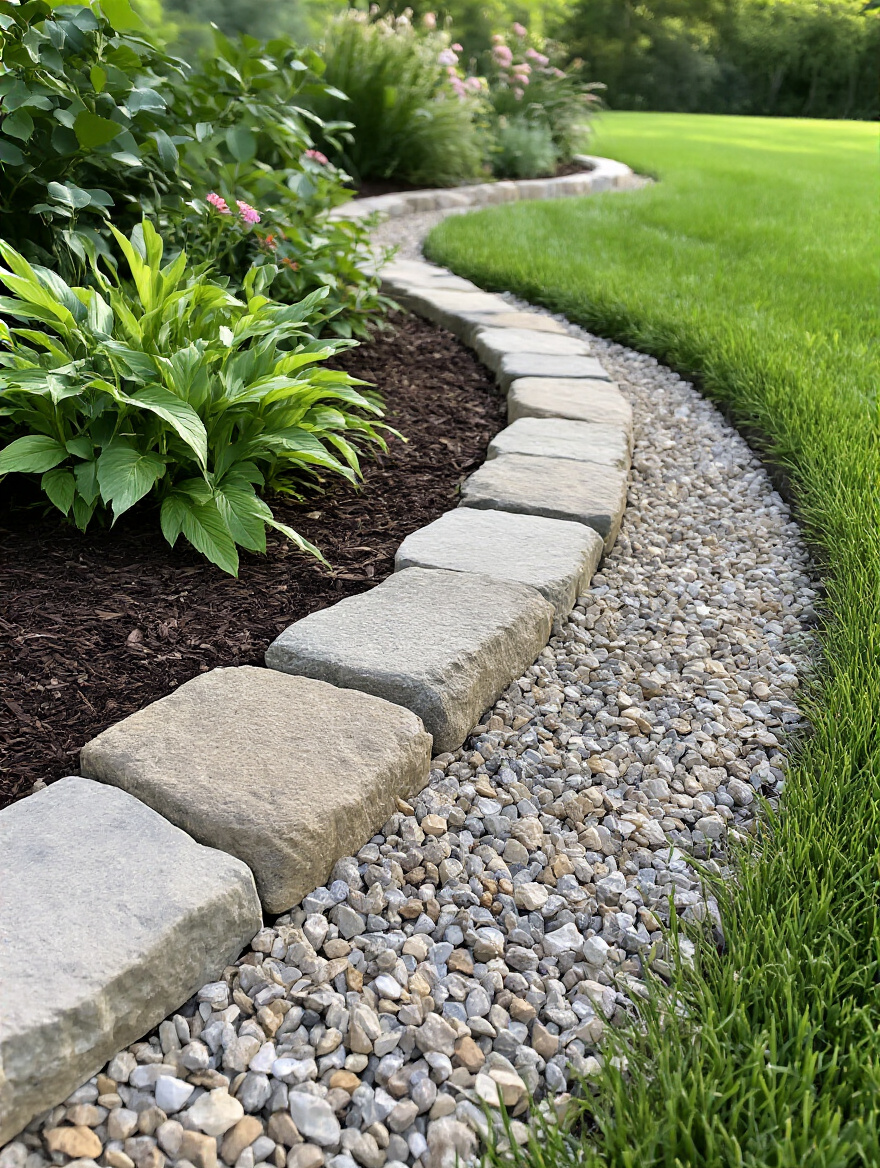
The tactile experience is wonderful, too. Choose stones that feel good to you—smooth, dark river rocks for a serene look, or rough-hewn, irregular flagstone for something more rustic. Running your hand over them connects you to the earth. A confession: I used to think this was purely decorative. But then I realized how much time I was saving on weeding and tidying up. The structure creates ease. It holds the energy of your garden beds, creating a container for life to flourish.
From the grounding edges, we now turn to the element that creates a magnetic center: fire.
8. Construct a DIY Fire Pit for Evening Gatherings
There is no element more primal and connective than fire. A fire pit instantly becomes the heart of an outdoor space, drawing people in like moths to a flame. The flicker of the light is neurologically soothing, the crackling sound is mesmerizing, and the warmth on your skin is pure comfort. This is a multi-sensory anchor for your entire yard. It encourages slow conversation and quiet connection.
And you absolutely don’t need a professionally installed one. A simple DIY fire pit, built from stone blocks over a weekend, creates the exact same magic. I tell my clients to think about the scent, too. I’ll often have them use apple or cherry wood, which release a subtly sweet, comforting aroma. One of my most cherished memories is of a client telling me her family had started a tradition of “fire pit Fridays,” putting their phones away and just talking. That’s the power of this simple circle of stone and flame—it builds connection.
To complement the warmth of the fire, creating a space for cool, daytime comfort is essential.
9. Build a Pergola to Add Shade and Structure
A pergola is like a whisper of a room. It gives you a sense of enclosure and intimacy without blocking the sky. What I love most about them is the play of light. They don’t create dense, heavy shade; they create a dynamic, dappled light that shifts and dances throughout the day. Lying under a pergola and watching the sun filter through the rafters is a meditation in itself. It’s incredibly calming for the nervous system.
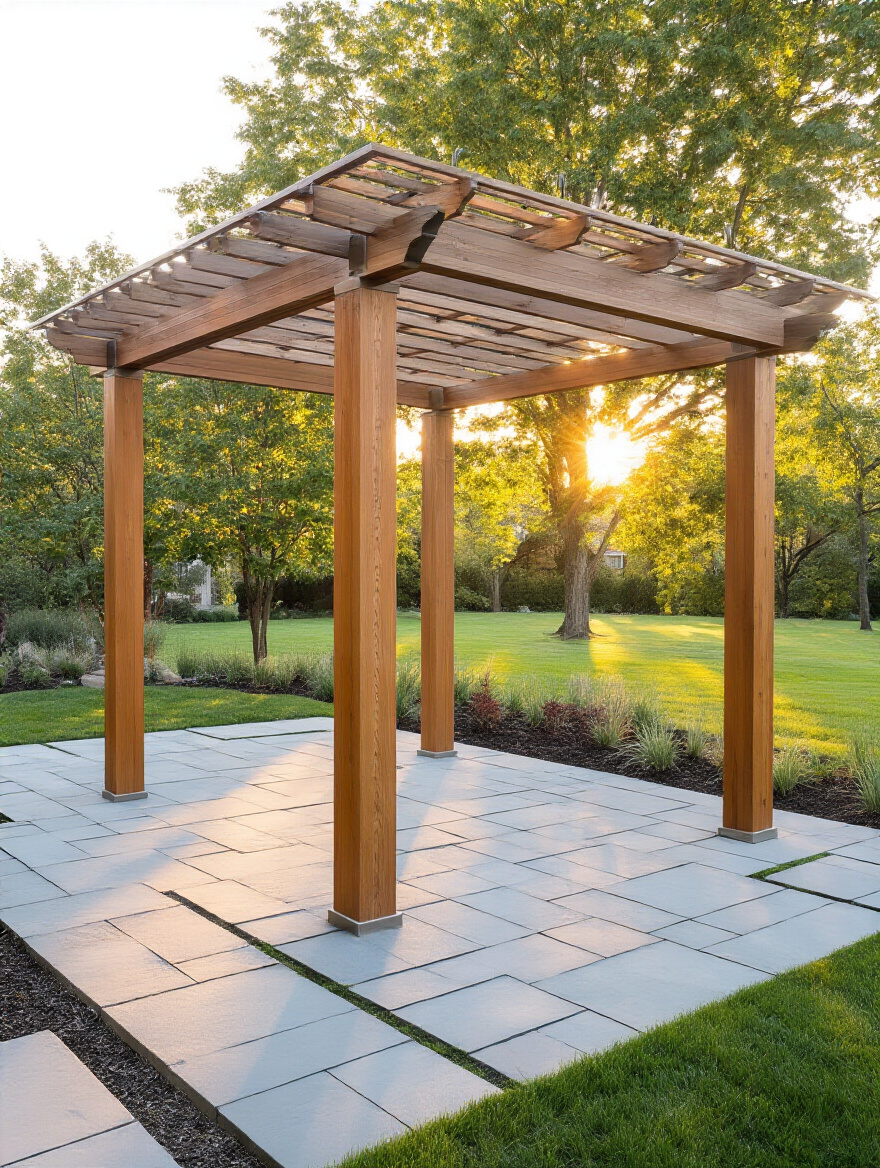
This is a perfect structure to bring in another layer of sensory experience: scent. Plant a climbing jasmine or a fragrant wisteria to weave through the rafters. On a warm evening, the structure will hold that beautiful aroma, creating a pocket of perfumed air. A pergola gives definition to a patio or deck, transforming it from a simple surface into an intentional destination—an elegant, breezy outdoor room you’ll never want to leave.
As you create these beautiful destinations, the feeling of true retreat comes from a sense of privacy.
10. Erect a Stylish Privacy Screen from Neighbors
Privacy is not about being antisocial; it’s about creating a sense of safety. Your nervous system cannot fully relax and enter a state of rest and digest if it feels exposed or on display. A privacy screen is an energetic boundary. It’s you telling your body, “This is our safe space. You can let go here.” It doesn’t have to be a solid, oppressive wall. A slatted wood screen allows for airflow and a beautiful play of light.
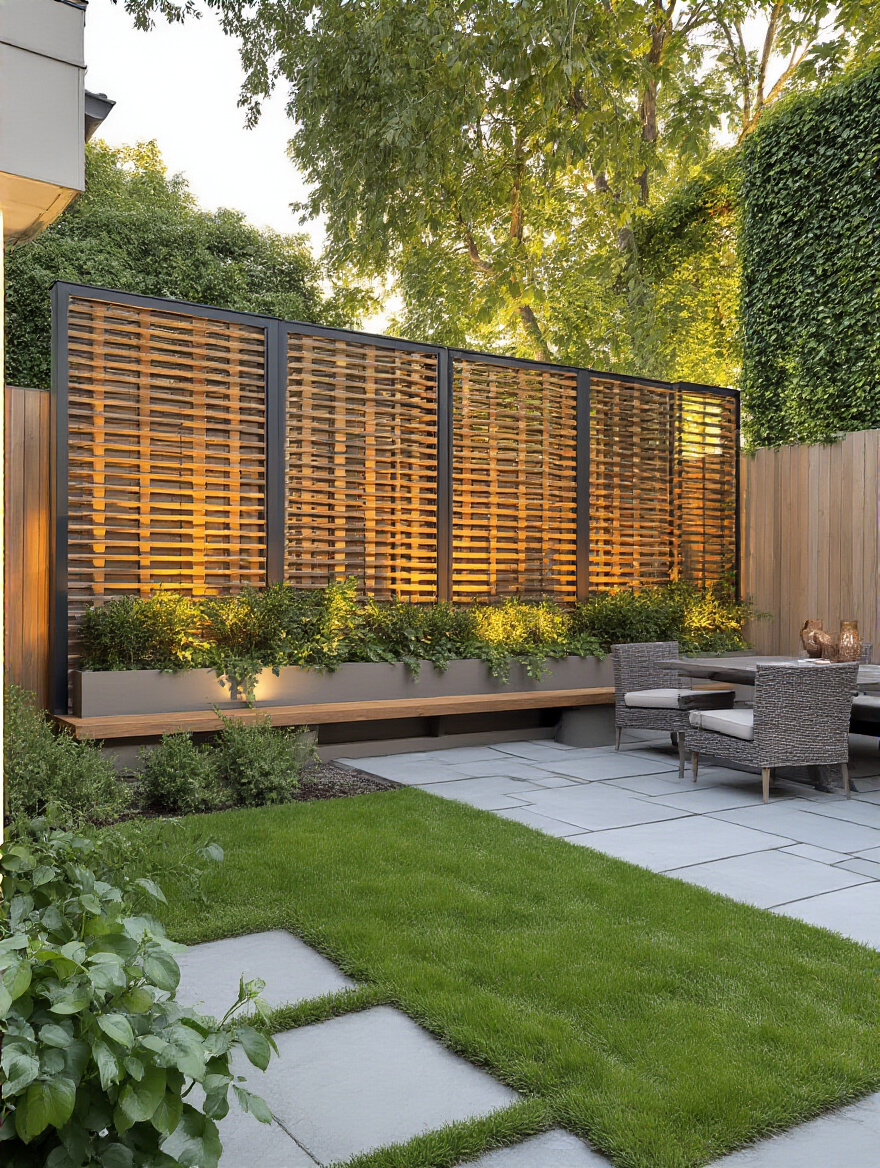
The right screen can also be a noise buffer. The gentle rustle of bamboo planted in front of a screen can help mask neighborhood noise, replacing it with a soothing natural sound. I once helped a client in a tight urban lot install a simple screen with planters for climbing vines. She said it was the single most transformative thing we did. Her tiny patio went from being a place she felt watched to being her private oasis, her “secret garden,” where she could have her morning coffee in peace.
With your destinations and privacy established, we connect them with paths that invite a journey.
11. Lay Decorative Stone Paths for Aesthetic Flow
A path is never just about getting from A to B. It’s an invitation. The way a path is designed dictates the pace and mood of your journey through the garden. A straight, wide path feels formal and direct. A gently curving path of stepping stones encourages you to slow down, to meander, to notice the plants along the way. It’s a practice in mindfulness built right into the landscape.
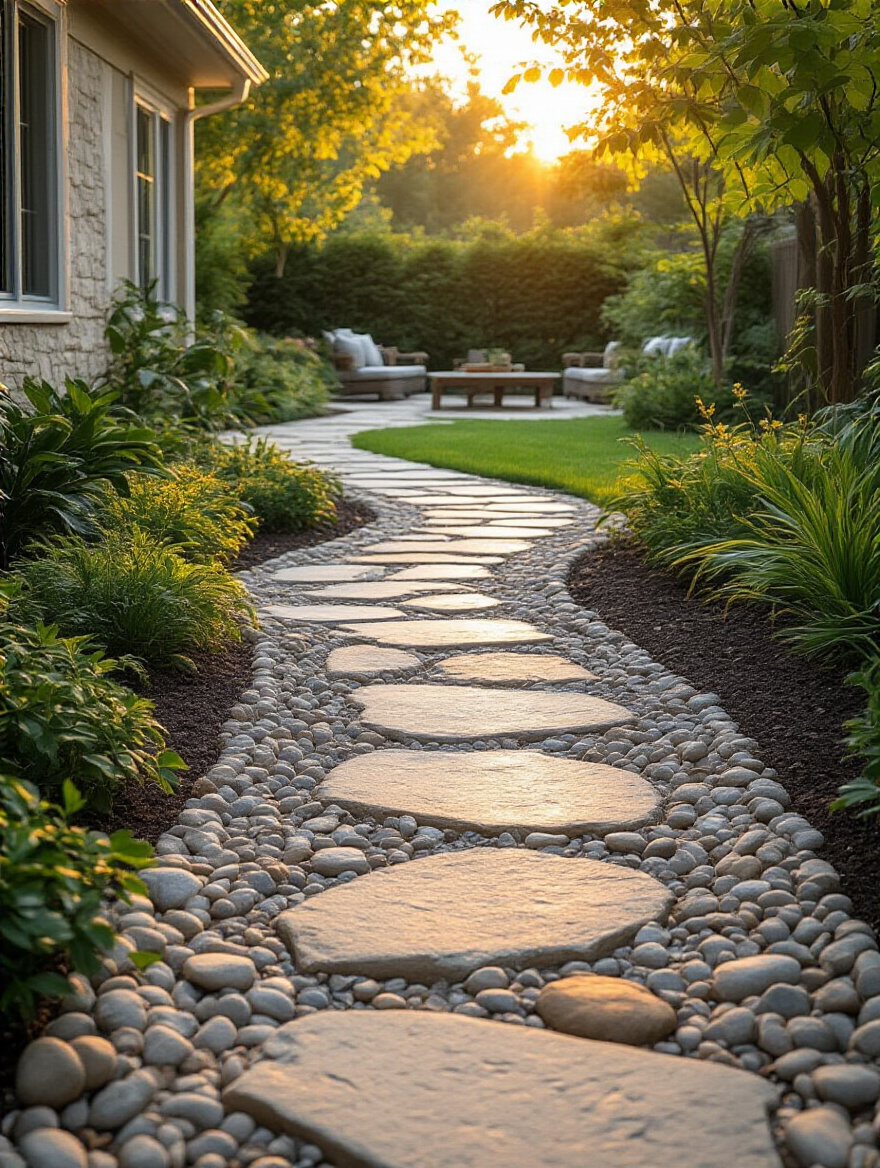
Think about the sound and feel. The satisfying crunch of pea gravel underfoot is one of my favorite garden sounds. The solid, cool feel of a large flagstone is grounding. You can use different materials to signal a transition from one “room” to another. Maybe a more formal paver path leads to the dining area, while a rustic mulch path leads to the compost pile. It adds a layer of intuitive navigation that makes the whole space feel more cohesive and thoughtful.
Cultivating Greenery & Ambiance
Now that the bones are in place, we get to flesh them out with life, color, scent, and light. This is where your sanctuary truly awakens. Greenery softens the hard lines, while carefully chosen ambiance transforms the space from day to night. This phase is all about seducing the senses, creating a rich tapestry of experiences that nourish your soul every time you step outside.
12. Design Low-Maintenance Flower Beds for Continuous Bloom
Please, let’s stop thinking about gardens as just being visual. A truly brilliant garden is a symphony of scents. When I design a flower bed, I’m thinking about the “scent-scape” across the seasons. A wave of hyacinth and narcissus in the spring, followed by fragrant peonies and roses in early summer, and then the spicy-sweet scent of phlox in late summer. This creates a dynamic experience that changes throughout the year.
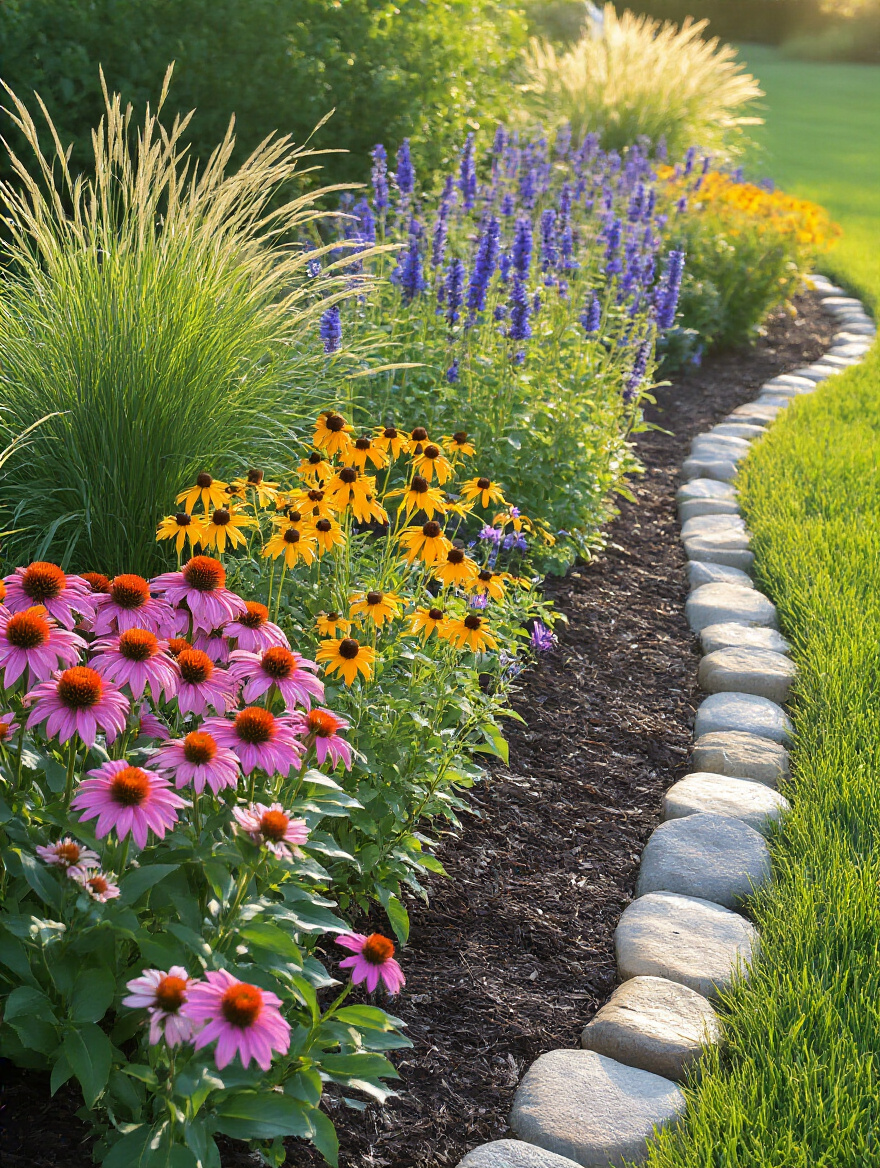
The trick to “low-maintenance” isn’t a secret; it’s just choosing the right plant for the right place. Working with your soil and sun exposure, not against it, is key. Planting in “drifts” or groups of 3, 5, or 7 looks more natural and lush than polka-dotting single plants around. And my favorite shortcut? A thick layer of mulch. It’s like a cozy blanket for your soil that keeps moisture in and weeds out. This isn’t about creating a chore; it’s about cultivating a living, breathing space that offers you beauty and aroma with generosity.
While you’re planting for the senses, don’t forget to look up and find new places to grow.
13. Start a Vertical Garden to Maximize Small Spaces
Even the smallest patio can be a bountiful, fragrant garden. A vertical garden transforms a blank wall or fence into a living tapestry of scent and flavor. This is one of my favorite backyard ideas for bringing wellness right to your fingertips. Imagine having a wall of herbs—rosemary for focus, mint for energy, basil for joy—just steps from your kitchen. The simple act of crushing a leaf between your fingers and inhaling the aroma is a potent, grounding moment.
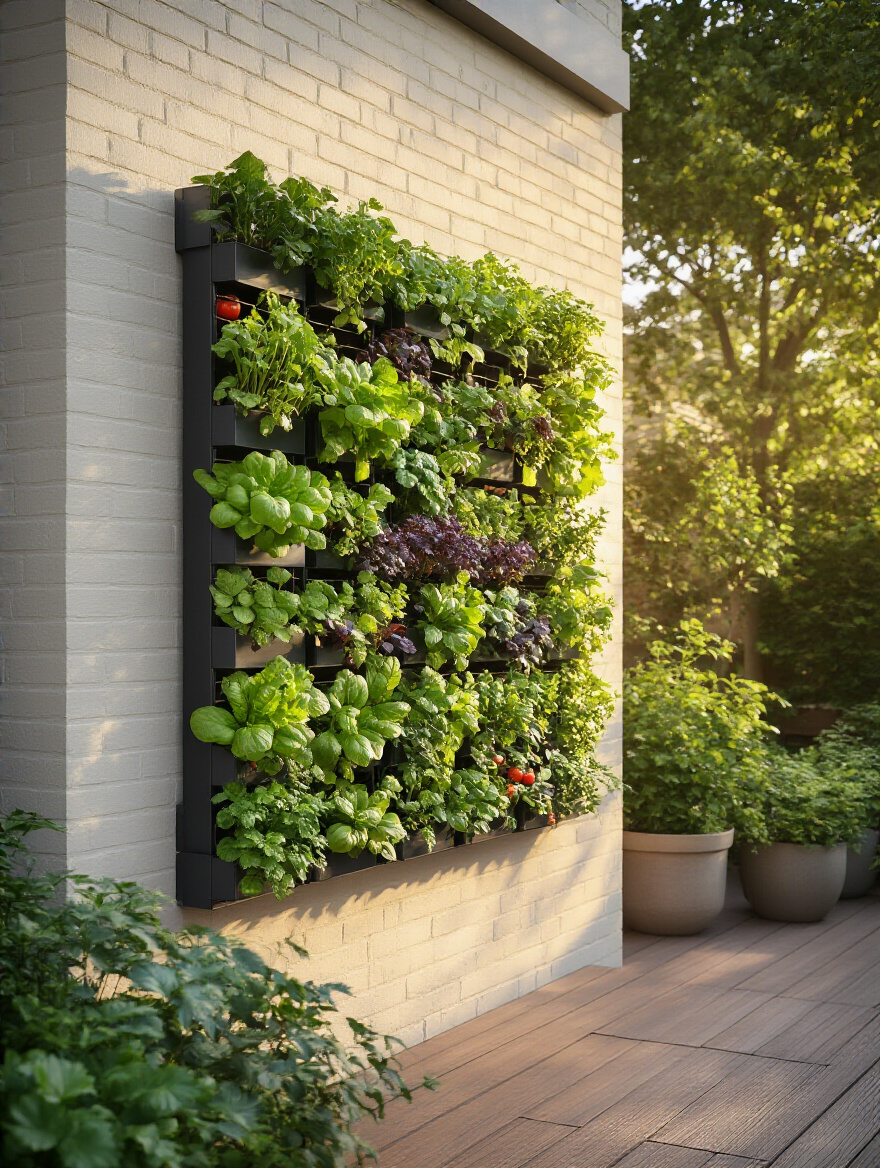
This isn’t just for small spaces, either. It’s an ergonomic dream. No bending, no kneeling. You can tend to your garden while standing comfortably. A client with chronic back pain thought her gardening days were over until we installed a wall-mounted system for her. She now grows all her own salad greens and herbs, and she says touching the plants and soil every day is her therapy. It connects you directly to the source of your nourishment, which is a powerful feeling.
Once your greenery is in, you can add the final layer of magic: light.
14. Incorporate Dimmable Outdoor Lighting for Evening Ambiance
Outdoor lighting isn’t just for safety; it’s for shaping emotion. And the secret to magical lighting is one word: dimmers. Bright, functional light is great for grilling, but it can feel harsh and clinical for relaxing. Being able to dim the lights down to a soft, warm glow is what transforms a patio into an intimate, romantic lounge. It signals to your nervous system that the day is winding down and it’s time to relax.
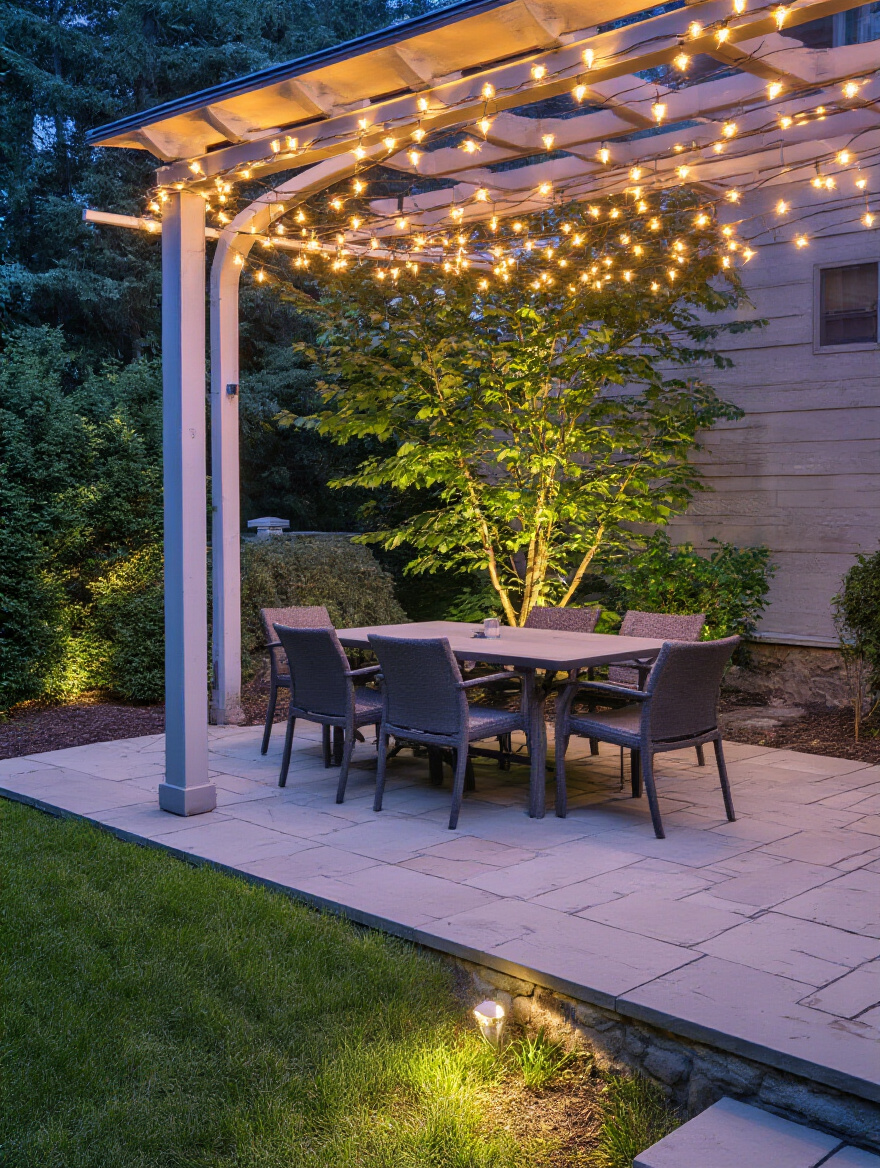
“The true magic of outdoor lighting isn’t just about visibility, but about crafting an experience. Dimmable systems empower homeowners to fluidly transition their outdoor spaces from functional to fantastical.”
Think in layers. Use subtle uplighting to highlight the beautiful texture of a tree trunk. Use path lights to create a gentle, guiding ribbon of light. Hang dimmable bistro lights overhead for that perfect ambient glow. It’s not about flooding the space with light; it’s about creating pockets of light and shadow. This drama and mystery is what makes a space feel enchanting after dark and extends your enjoyment of it for hours.
And in that beautifully lit space, comfort is the ultimate luxury.
15. Choose Ergonomic Outdoor Furniture for Comfort
You can have the most stunning backyard in the world, but if your chairs are uncomfortable, you will not use it. It’s that simple. True comfort is a sensory experience. It’s the feeling of your body being held and supported, allowing your muscles to release and your mind to settle. So many outdoor chairs look great but are terribly designed for the human body. Your well-being is more important than an aesthetic.

When you shop, actually sit in the furniture. For a while. Do you feel supported? Is there pressure on your lower back? Can your feet rest comfortably on the ground? Look for materials that feel good on the skin and cushions that are substantial. This investment in comfort is an investment in time—the hours you’ll spend lingering, reading, and connecting with loved ones because your body is at ease. This isn’t an indulgence; it’s a foundational element of a restful space.
To elevate that rest into profound tranquility, we add the most soothing sound in nature.
16. Build a Calming Pond or Serene Water Feature
There is a scientific reason why we are drawn to the sound of water. It has a unique ability to mask jarring, intermittent noises (like traffic or a neighbor’s dog) with a steady, consistent, and broad-spectrum sound. This “auditory masking” has a profound calming effect on our brains, lowering our heart rate and reducing stress. A simple fountain or small pond can be the most powerful piece of sound therapy you put in your yard.
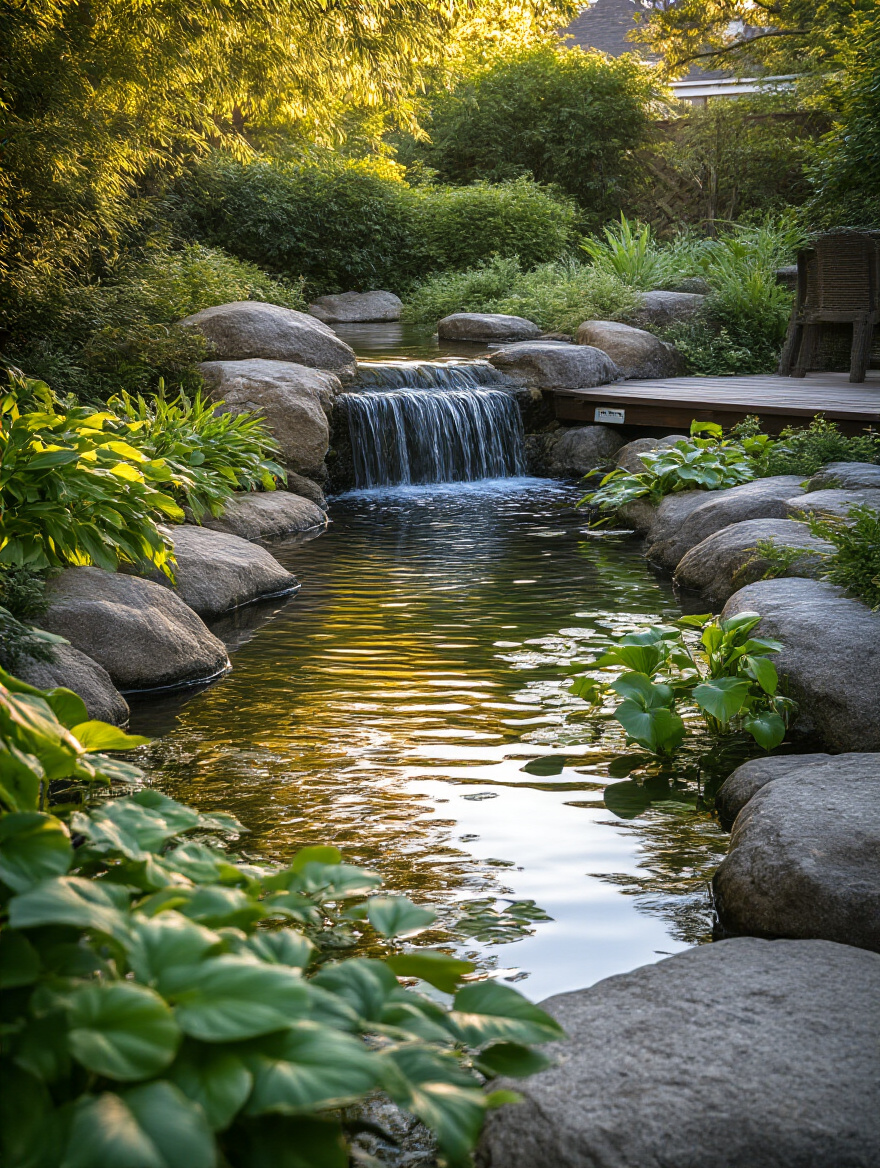
It’s a visual meditation, too. Watching the reflection of the sky on the water’s surface or the gentle dance of a water lily is endlessly fascinating and peaceful. And you’ll be creating a micro-habitat. The sight and sound of birds splashing in a fountain or dragonflies zipping over a pond connects you to the wider web of life. A client once told me his little bubble fountain was “like a Xanax for his backyard.” He wasn’t wrong.
You can amplify that connection to nature by being intentional with every plant you choose.
17. Plant Native Species to Attract Beneficial Wildlife
Planting native species is an act of deep kindness—to your local ecosystem and to yourself. These are the plants that have co-evolved with the birds, bees, and butterflies in your area. They provide the perfect food and shelter. When you plant natives, your garden will come alive with a subtle hum and flutter of activity. It becomes a living, breathing part of the local landscape, not an isolated bubble.
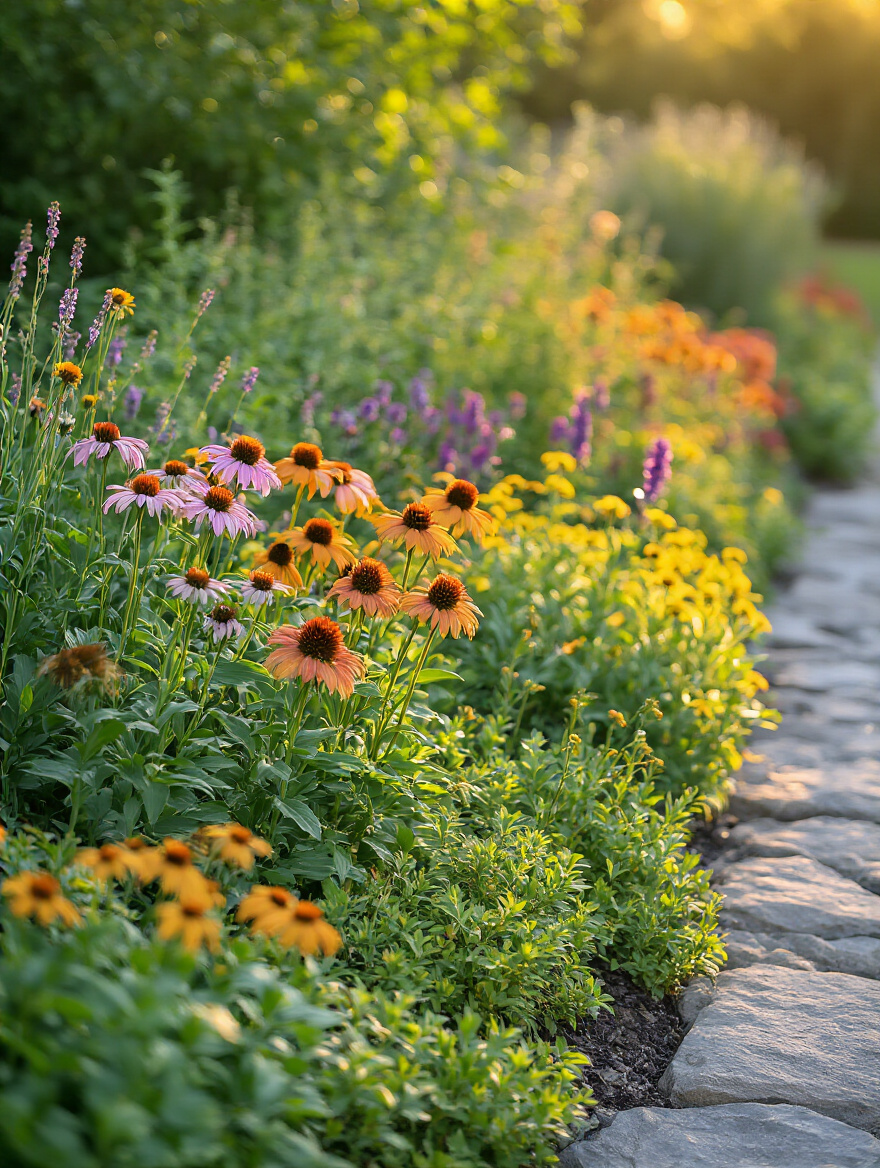
Because they are perfectly adapted to your climate, native plants are the definition of low-maintenance once established. They require less water, less fuss, and no chemical fertilizers. It’s about letting go of control and inviting nature in. There is an immense sense of satisfaction and peace that comes from creating a space that gives back, that supports life. Listening to the buzz of happy pollinators is one of the most rewarding sounds a garden can offer.
Sustainable Enhancements & Modern Comforts
This final layer is about mindful living. It’s where we integrate smart, gentle technology and practices that align our sanctuary with our values. These enhancements aren’t about creating a high-tech, complicated space. They are about using modern wisdom to create more ease, conserve resources, and deepen our connection to the natural cycles of our own backyard.
18. Install a Smart Irrigation System to Conserve Water
Water is life, and using it wisely is a beautiful act of stewardship. A smart irrigation system is the opposite of a “dumb” timer that waters on a schedule, rain or shine. It’s an intuitive system that listens to the environment. It checks the local weather forecast, knows if it’s about to rain, and adjusts accordingly. It learns the specific needs of your lawn versus your flower beds.
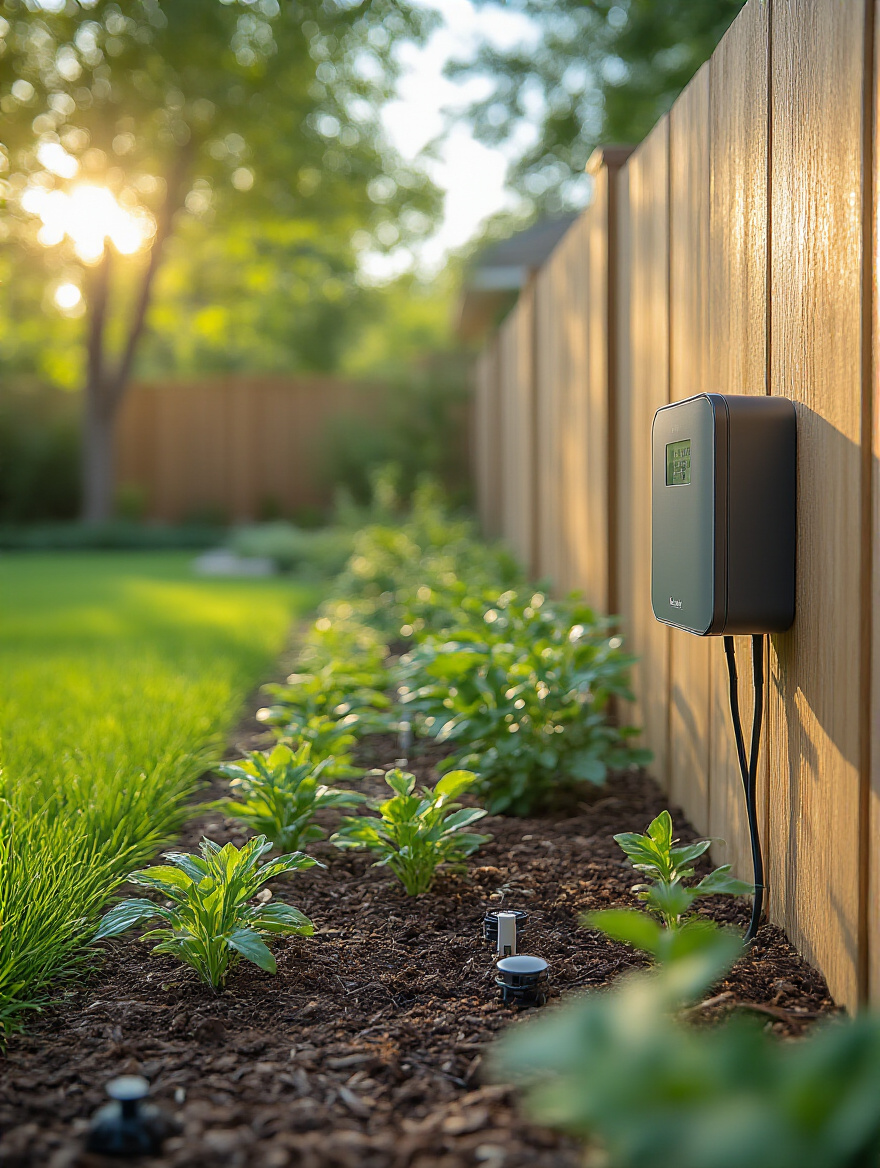
This is technology in service of nature. It ensures your plants get exactly what they need to thrive, without waste. It takes the guesswork and anxiety out of watering, especially during dry spells. I had a client who was constantly stressed about her water bill and whether she was watering correctly. Installing a smart system gave her total peace of mind. It’s a quiet, background system that fosters abundance with intelligence and care.
Finally, we close the loop, turning our garden’s “waste” into its greatest treasure.
19. Set Up a Composting Station for Eco-Friendly Garden Nourishment
Composting is pure alchemy. It’s the magical process of turning kitchen scraps and yard trimmings into ‘black gold’—the most incredible, nutrient-rich food for your soil. There is something profoundly grounding about participating in this cycle of decay and rebirth. The scent isn’t foul; a healthy compost pile smells rich and earthy, like a forest floor. It’s the smell of life itself.
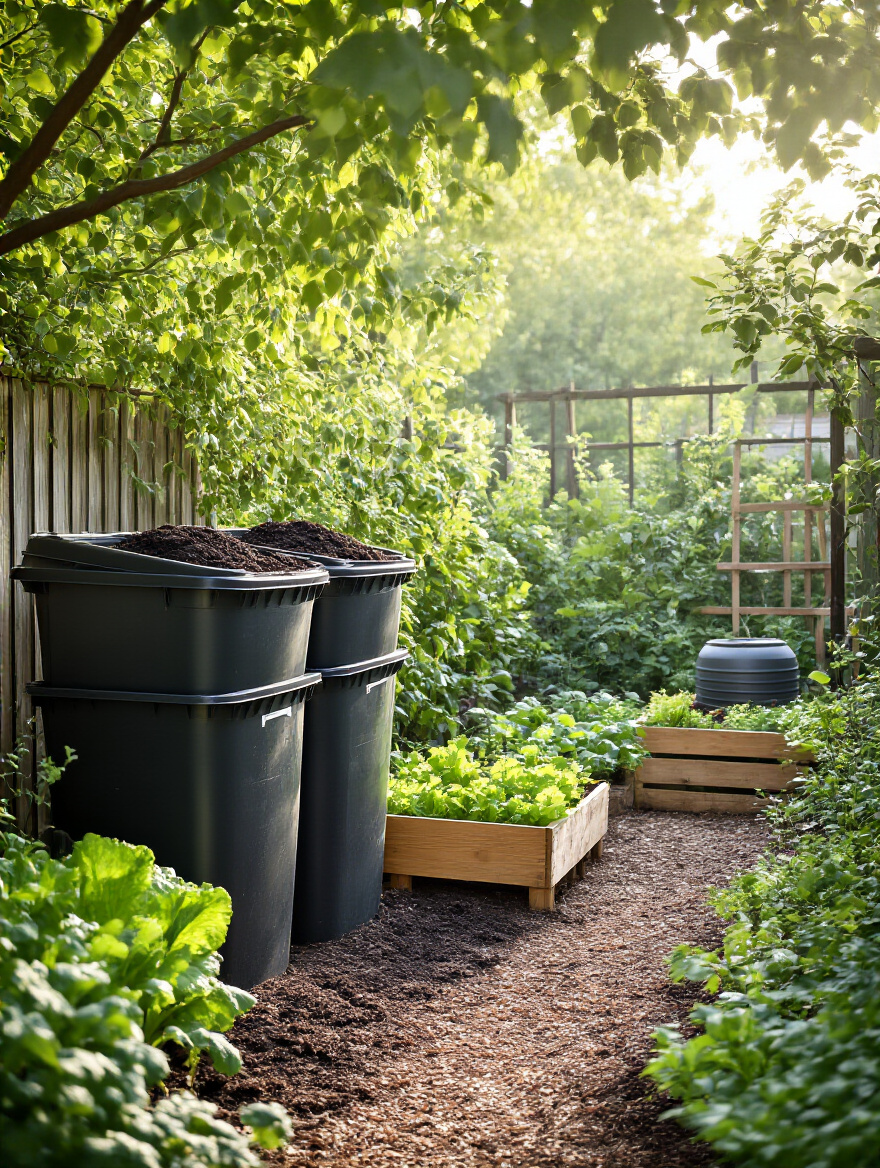
Setting up a simple bin or pile is all it takes to start. By feeding your garden with compost, you’re building a living, resilient soil full of beneficial microbes. Your plants will be healthier, stronger, and more resistant to pests and diseases, reducing any need for chemicals. It’s a simple, powerful act that reduces landfill waste and connects you directly to the foundational cycle of your garden’s health. It’s the ultimate expression of a backyard that is truly a self-sustaining sanctuary.
Conclusion
Creating a backyard that truly nourishes you is a journey, not a weekend project. It’s about weaving together threads of sight, sound, scent, and touch until you have a space that feels like a natural extension of your own heart. We’ve talked about building the strong bones with thoughtful planning and hardscapes, and then bringing it to life with plants, light, and water. Each idea is a step toward a more holistic, sensory-rich environment.
Remember that this is your sanctuary. It should reflect the way you want to feel. Maybe you start with just one thing—a comfortable chair in a shady spot, or a pot of fragrant lavender by the door. That’s enough. Begin by listening—to the land, to your senses, to your own quiet needs. Your backyard has so much potential to be a place of deep rest, joyful connection, and daily inspiration. Step outside, take a deep breath, and let the transformation begin.
